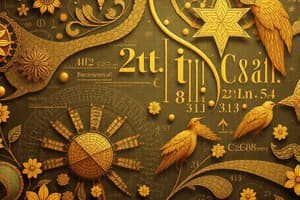Podcast
Questions and Answers
Which operation represents the process of finding the value that is halfway between two numbers?
Which operation represents the process of finding the value that is halfway between two numbers?
- Subtraction
- Averaging (correct)
- Addition
- Multiplication
What is the primary purpose of a derivative in calculus?
What is the primary purpose of a derivative in calculus?
- Calculating the area under a curve
- Predicting future values of a dataset
- Finding the maximum value of a function
- Determining the slope of a curve at a point (correct)
In probability, what does it mean if two events are independent?
In probability, what does it mean if two events are independent?
- Both events cannot occur at the same time
- The occurrence of one event affects the likelihood of the other
- The probability of both events occurring is the product of their individual probabilities (correct)
- Neither event can happen at all
Which theorem is applied to relate the sides of a right triangle?
Which theorem is applied to relate the sides of a right triangle?
What is the primary measure of central tendency used to describe the most frequently occurring value in a dataset?
What is the primary measure of central tendency used to describe the most frequently occurring value in a dataset?
What mathematical symbol represents inequality between two expressions indicating one is less than the other?
What mathematical symbol represents inequality between two expressions indicating one is less than the other?
In statistical analysis, what does the standard deviation measure?
In statistical analysis, what does the standard deviation measure?
Which of the following is a common mistake when applying the order of operations?
Which of the following is a common mistake when applying the order of operations?
Which term best describes the smallest shared multiple of two integers?
Which term best describes the smallest shared multiple of two integers?
In trigonometry, what does the sine of an angle represent?
In trigonometry, what does the sine of an angle represent?
Flashcards are hidden until you start studying
Study Notes
Key Areas of Mathematics
-
Arithmetic
- Basic operations: addition, subtraction, multiplication, division.
- Fractions, decimals, percentages.
-
Algebra
- Variables, constants, coefficients.
- Expressions, equations, inequalities.
- Functions: linear, quadratic, polynomial.
-
Geometry
- Properties of shapes: triangles, circles, polygons.
- Perimeter, area, volume calculations.
- Theorem application (e.g., Pythagorean theorem).
-
Trigonometry
- Ratios of sides: sine, cosine, tangent.
- Unit circle and angle measurement (degrees/radians).
- Applications in real-world problems.
-
Calculus
- Derivatives: rate of change, slopes of curves.
- Integrals: area under curves, accumulation of quantities.
- Limits: understanding behavior of functions as they approach a point.
-
Statistics
- Data collection, organization, and interpretation.
- Measures of central tendency: mean, median, mode.
- Variability measures: range, variance, standard deviation.
-
Probability
- Basic concepts: outcomes, events, experiments.
- Probability rules: addition and multiplication rules.
- Conditional probability and independence.
-
Number Theory
- Prime numbers, factors, and multiples.
- Divisibility rules.
- Essential concepts: greatest common divisor (GCD), least common multiple (LCM).
-
Mathematical Logic
- Statements, truth values, and logical connectives.
- Valid arguments and proof techniques (induction, contradiction).
Important Concepts
-
Mathematical Symbols
- Common symbols: + (addition), - (subtraction), × (multiplication), ÷ (division), = (equality).
-
Order of Operations
- Parentheses, Exponents, Multiplication and Division (left to right), Addition and Subtraction (left to right) - PEMDAS/BODMAS rule.
-
Functions and Graphs
- Domain and range of functions.
- Linear vs. non-linear functions and their graphical representations.
-
Critical Thinking in Math
- Problem-solving strategies, logical reasoning, and analysis of patterns.
Applications of Mathematics
-
Everyday Life
- Budgeting, personal finance, cooking measurements.
-
Science and Engineering
- Physics problems, engineering designs, statistical analyses.
-
Technology
- Algorithms, data processing, cryptography.
Study Tips
- Practice regularly with varied problem sets.
- Understand concepts rather than memorizing procedures.
- Utilize visual aids (graphs, charts) for better comprehension.
- Work in groups to discuss and solve problems collaboratively.
Key Areas of Mathematics
- Arithmetic
- Foundation of basic mathematical operations: addition, subtraction, multiplication, and division.
- Understanding fractions, decimals, and percentages is crucial.
- Algebra
- Introduces variables, constants, and coefficients, allowing for representation of unknown quantities.
- Equations, inequalities, and expressions are used to solve for unknown values.
- Examines different types of functions, including linear, quadratic, and polynomial functions.
- Geometry
- Explores the properties of shapes like triangles, circles, and polygons.
- Focuses on calculations of perimeter, area, and volume.
- Applications of theorems like the Pythagorean theorem are essential.
- Trigonometry
- Deals with ratios of sides within right triangles (sine, cosine, tangent).
- Emphasizes the unit circle and various angle measurements in degrees and radians.
- Applied in solving real-world problems involving angles and distances.
- Calculus
- Focuses on derivatives, which measure the rate of change in a function.
- Integrals are used to calculate the area under a curve and accumulate quantities.
- Examines the behavior of functions as they approach a specific point (limits).
- Statistics
- Involves gathering, organizing, and interpreting data sets.
- Provides measures of central tendency (including mean, median, and mode).
- Explores measures of variability – range, variance, and standard deviation.
- Probability
- Explores concepts like outcomes, events, and experiments.
- Focuses on probability rules such as addition and multiplication rules.
- Examines principles of conditional probability and independence.
- Number Theory
- Explores prime numbers, factors, and multiples.
- Covers divisibility rules and essential concepts like the greatest common divisor (GCD) and the least common multiple (LCM).
- Mathematical Logic
- Deals with statements, truth values, and logical connectives.
- Examines valid arguments and various proof techniques (induction, contradiction).
Important Concepts
- Mathematical Symbols
- Common symbols include:
-
- (addition)
-
- (subtraction)
- × (multiplication)
- ÷ (division)
- = (equality)
-
- Common symbols include:
- Order of Operations
- The PEMDAS/BODMAS rule dictates the order of operations:
- Parentheses/Brackets
- Exponents/Orders
- Multiplication and Division (left to right)
- Addition and Subtraction (left to right)
- The PEMDAS/BODMAS rule dictates the order of operations:
- Functions and Graphs
- Functions have a domain (input values) and a range (output values).
- Linear functions are represented graphically as straight lines, while non-linear functions have curved graphs.
- Critical Thinking in Math
- Solving math problems requires problem-solving strategies, logical reasoning, and the ability to analyze patterns.
Applications of Mathematics
- Everyday Life
- Mathematics is crucial for budgeting, personal finance, and even cooking measurements.
- Science and Engineering
- Physics problems, engineering designs, and various statistical analyses rely heavily on math.
- Technology
- Mathematics plays a vital role in algorithms, data processing, and cryptography.
Study Tips
- Practice math regularly using diverse problem sets.
- Instead of rote memorizing formulas, focus on understanding the underlying concepts.
- Utilize visual aids like graphs and charts to enhance comprehension.
- Engage with others by working in groups to discuss and solve problems collaboratively.
Studying That Suits You
Use AI to generate personalized quizzes and flashcards to suit your learning preferences.




